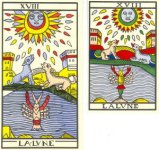kwaw
The eclipse of the Sun, the conjunction of the Bride and Bridegroom, mixed as it is here with the concept of lamentation, calls to mind that part of the Osiris/Isis myth of the magical conception of Horus to Isis when she was in mourning [and perhaps there are parallels with the immaculate conception, the gateway of heaven between two pillars?]. I don't see this card primarily as being about 'horror and madness', but of initiation and rebirth, the realization of the illusionary nature of death and temporal time; a hierophany in which through the continuity of life the eternal is glimpsed.
"She carried the box back to Egypt and placed it in the house of the gods. She changed herself into a bird and flew about his body, singing a song of mourning. Then she perched upon him and cast a spell. The spirit of dead Osiris entered her and she did conceive and bear a son whose destiny it would be to avenge his father. She called the child Horus, and hid him on an island far away from the gaze of his uncle Seth."
Kwaw
"She carried the box back to Egypt and placed it in the house of the gods. She changed herself into a bird and flew about his body, singing a song of mourning. Then she perched upon him and cast a spell. The spirit of dead Osiris entered her and she did conceive and bear a son whose destiny it would be to avenge his father. She called the child Horus, and hid him on an island far away from the gaze of his uncle Seth."
Kwaw


